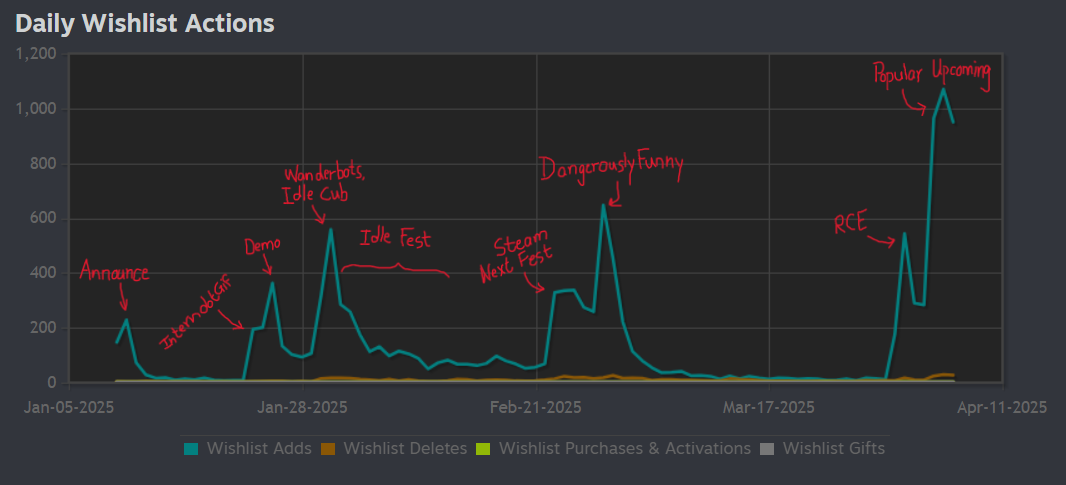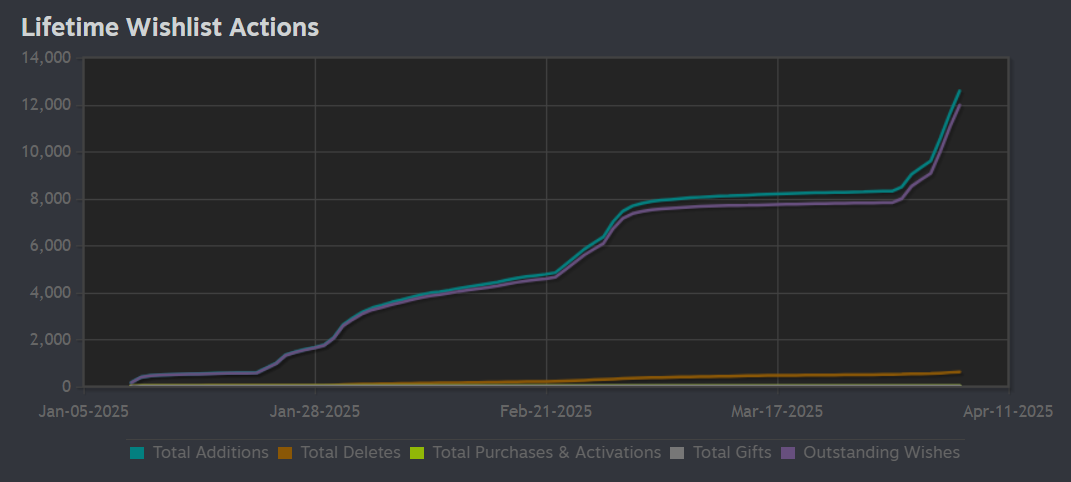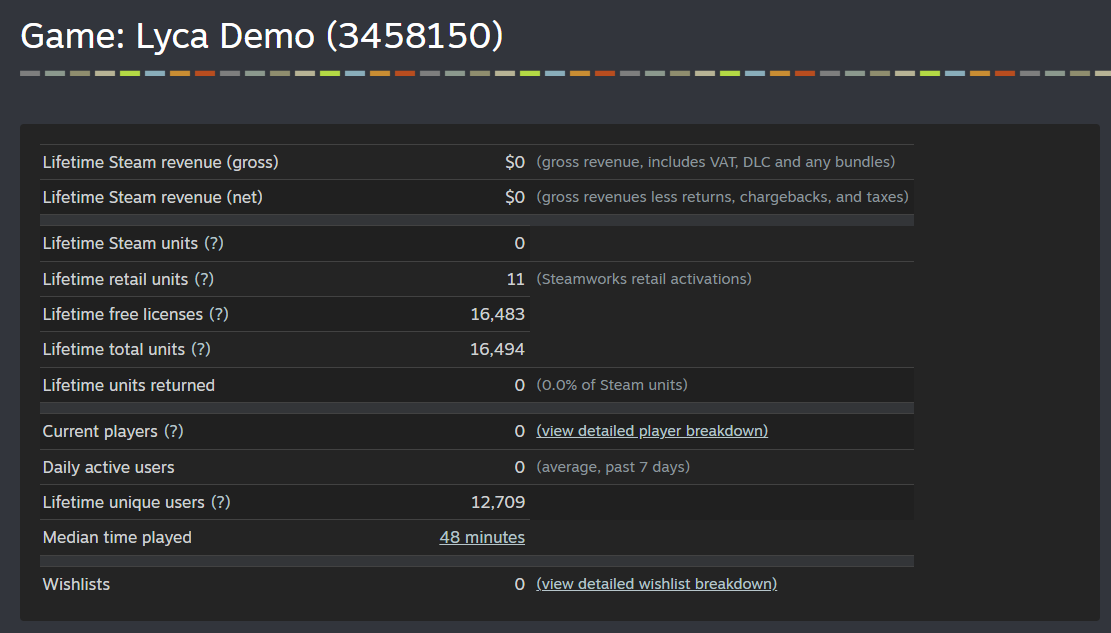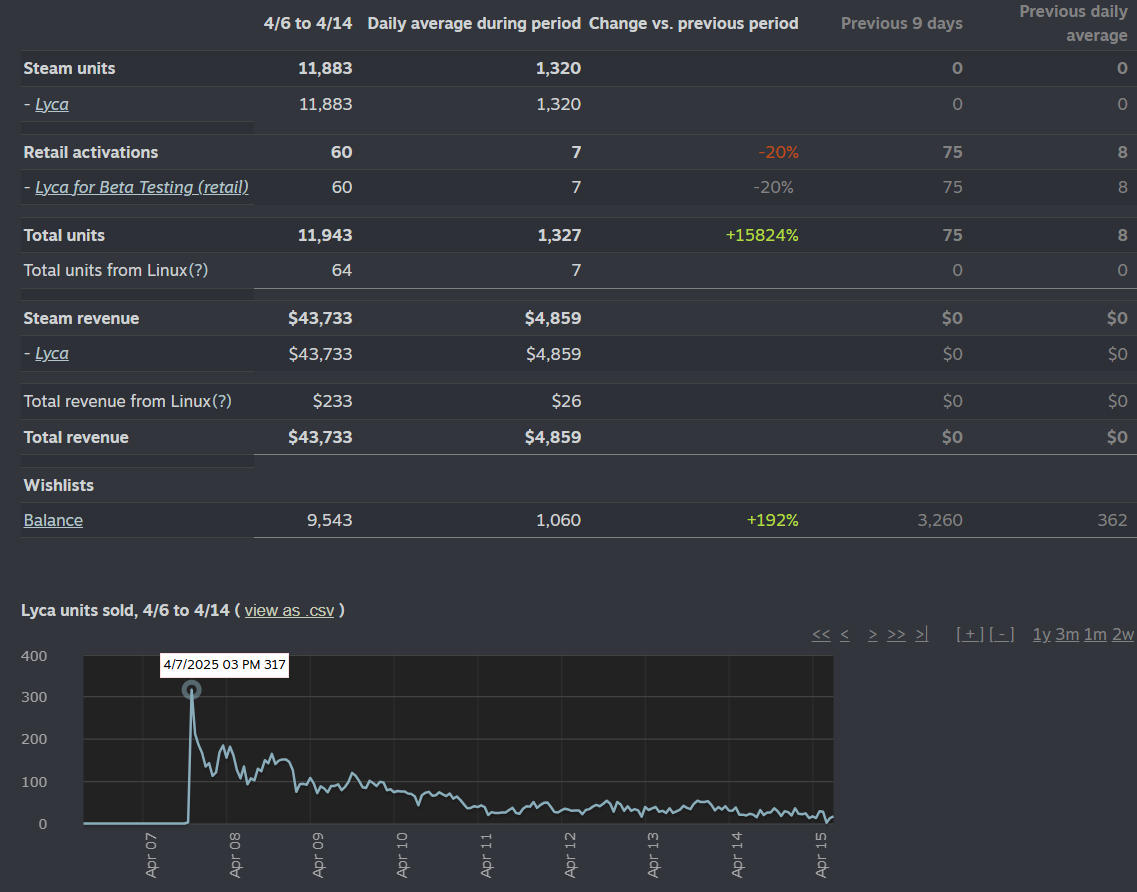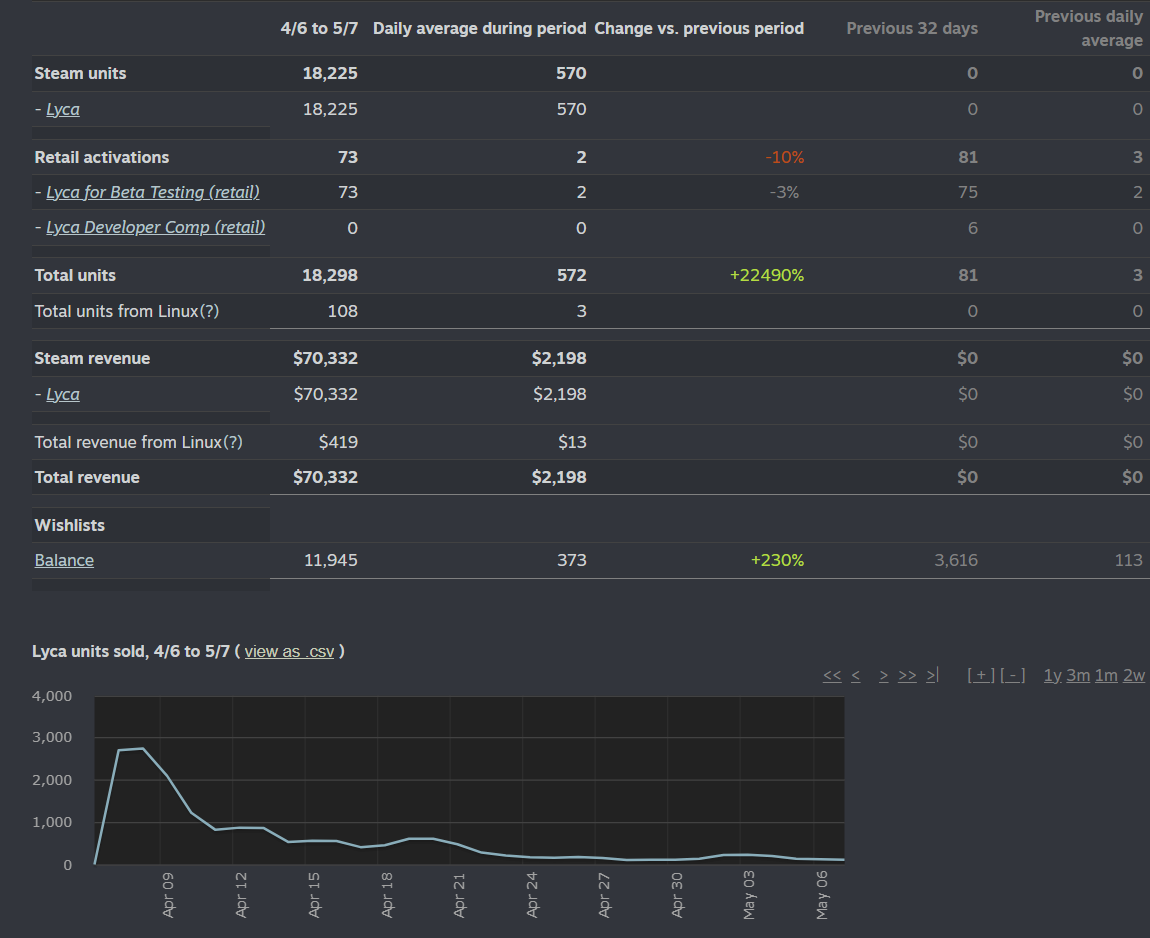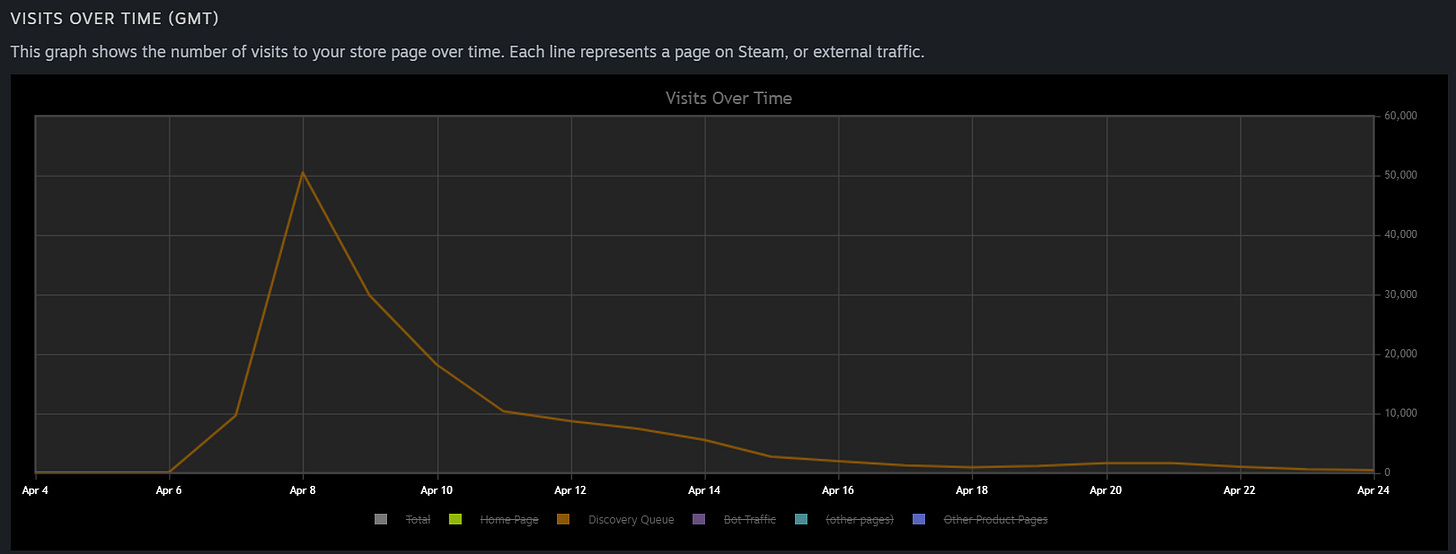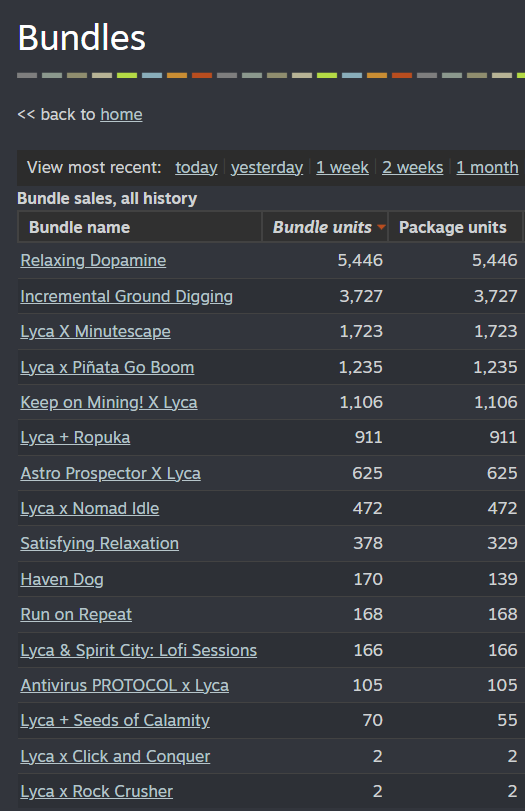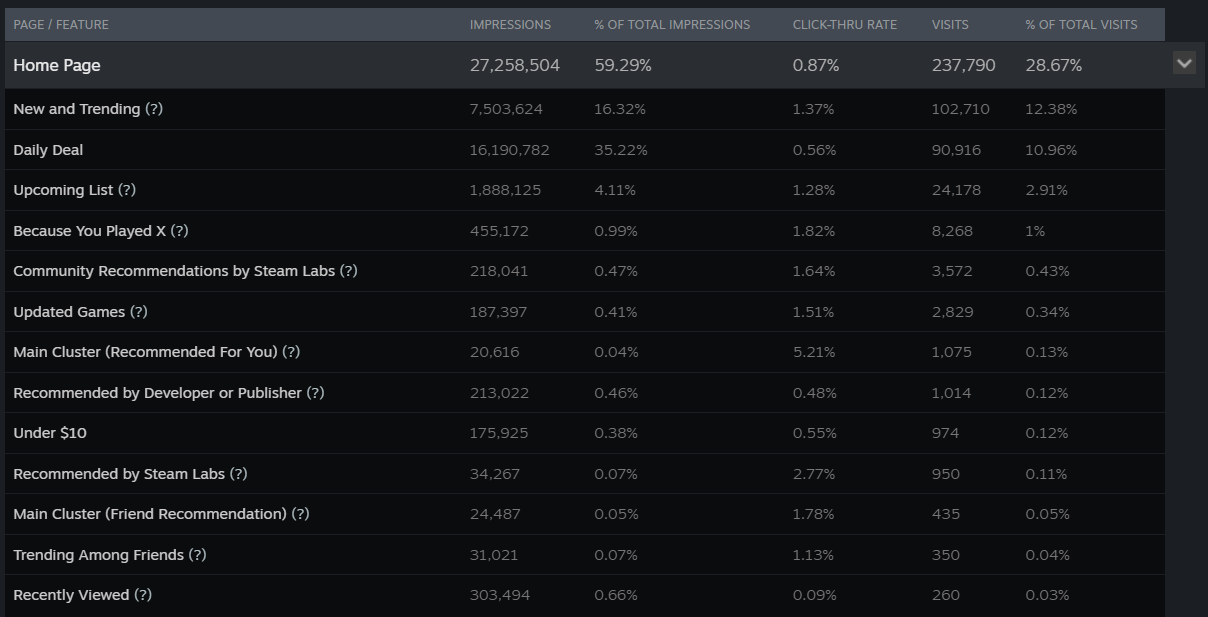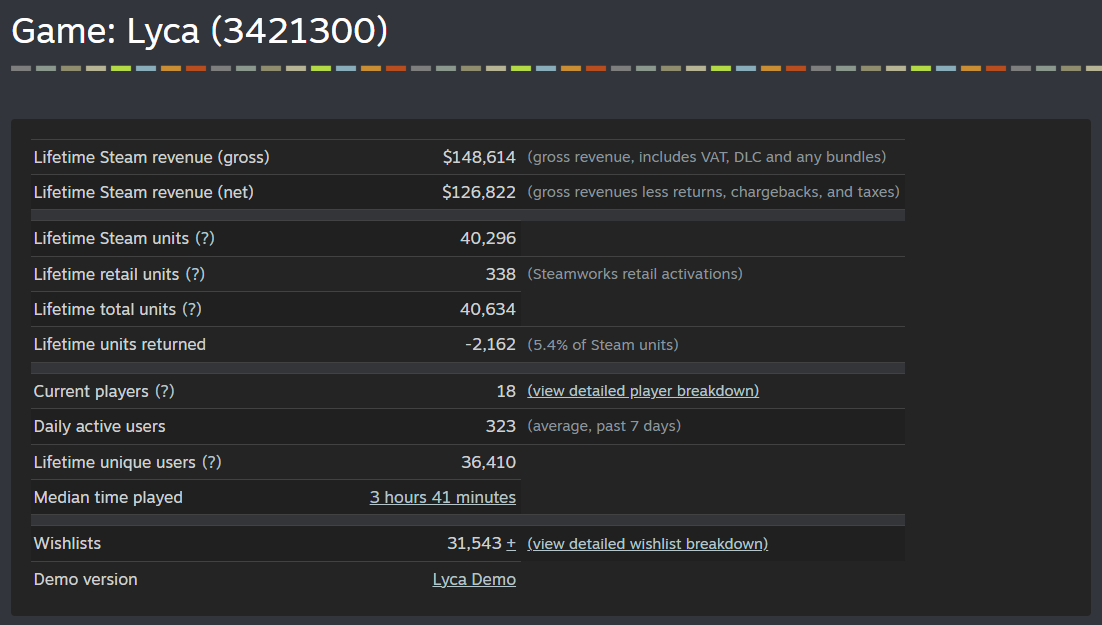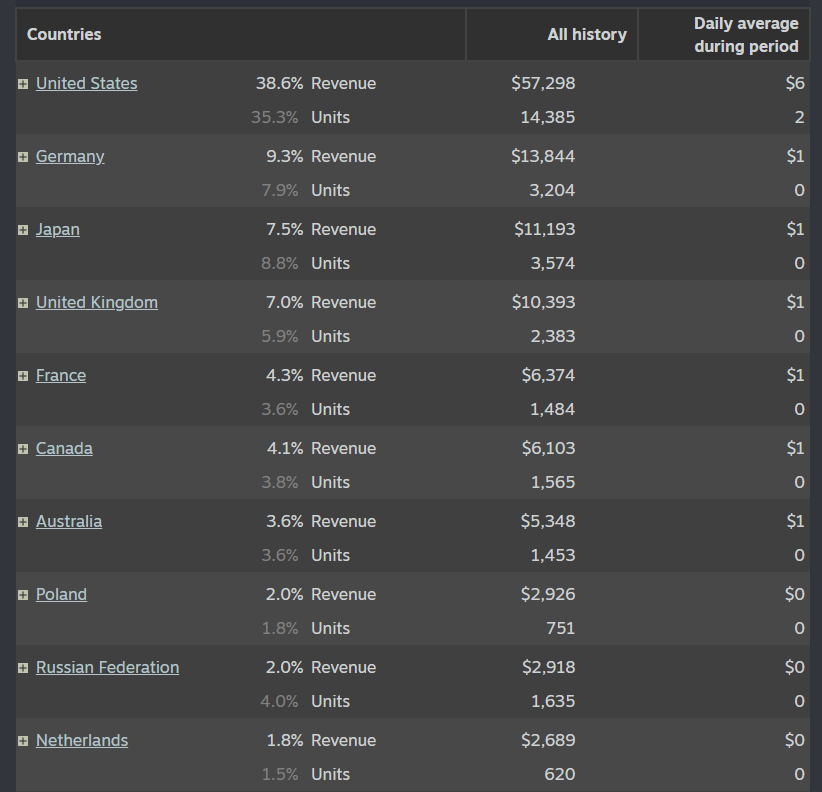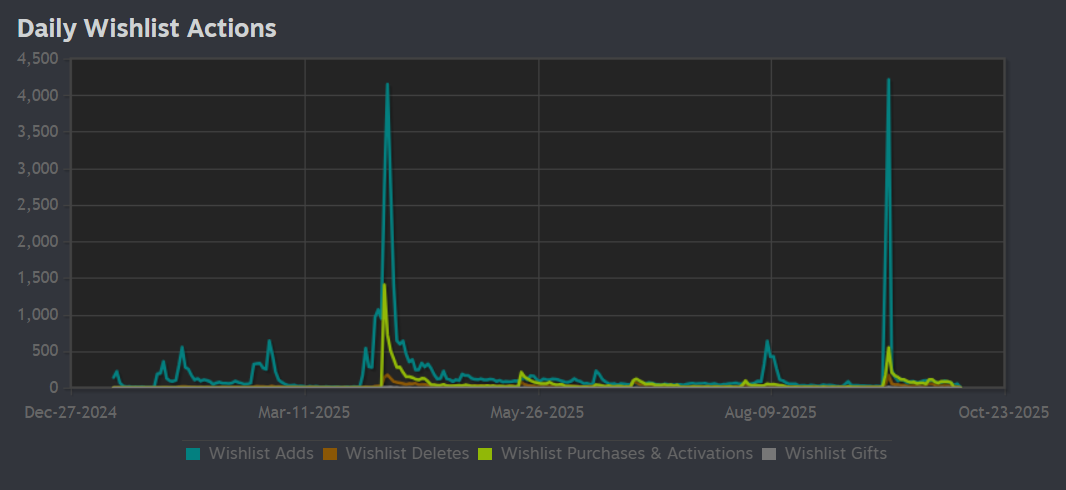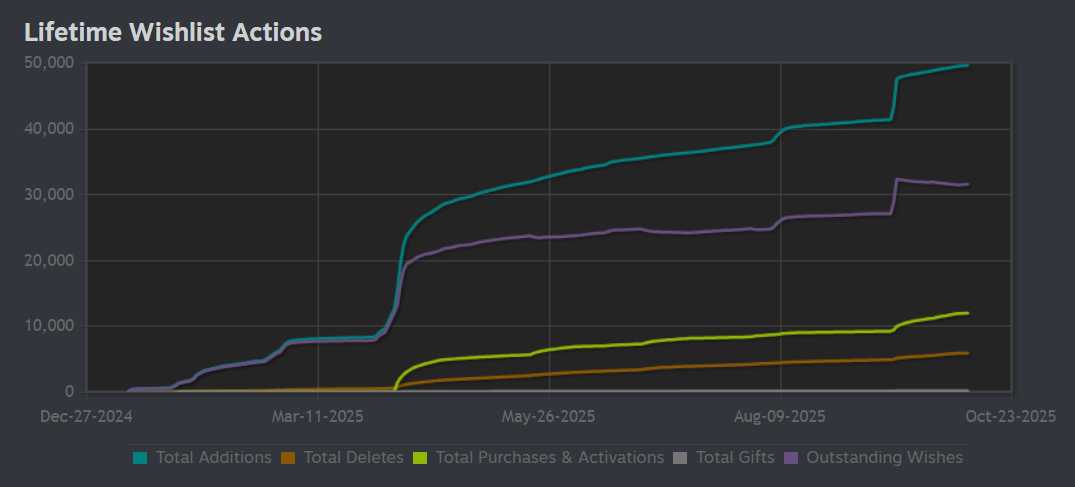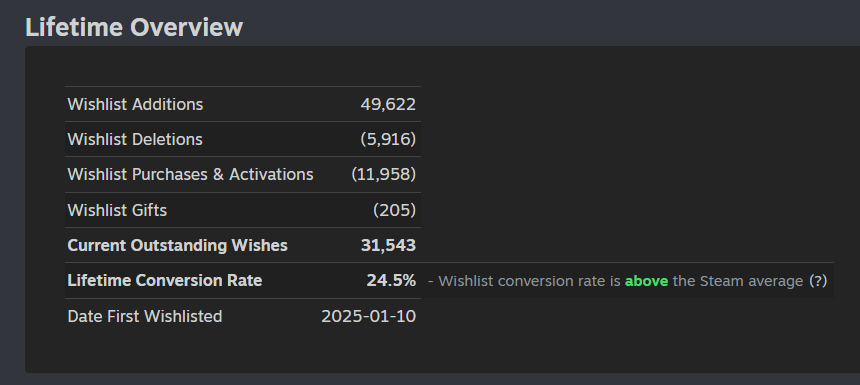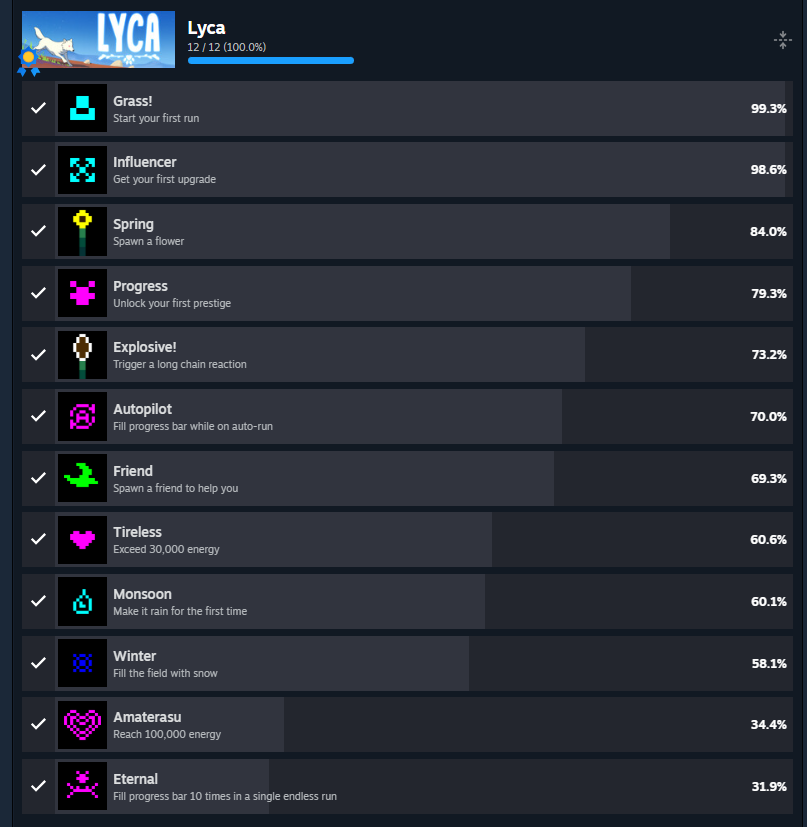Blog #2 - Lyca Analysis and Learnings
All stats and numbers from Lyca
Welcome to the Syphono4 Blog post #2! It’s been over 6 months since the launch of Lyca, so I think this is the perfect time to document a breakdown of all the numbers related to the game (pre and post launch), my analysis of those numbers, and the learnings and takeaways I’ll be carrying over to the next projects. Again, this blog is mostly for my own documentation (to refer back to), but I’ve kept it open for anyone interested. This is going to be a long one!
Note: This blog was written on 9 October 2025. All stats and numbers are up to date only until the date of writing.
Lyca - Analysis and Learnings
TLDR: ⏰
Content Creators and Steam Next Fest were the 2 major sources of Wishlists for Lyca pre-release (got ~12000 WLs at launch)
Demo stats were great, significantly above average, which helped a ton with Wishlists and validation
Follower to Wishlister ratio for Lyca was very very low pre-launch (~1:24), most likely because it’s a tiny game in a more cozy/wholesome tone
I think I managed to hit a sweet spot with the price of the game, with frequent discounts and regional pricing
Launch was very successful, Monday launch strategy paid off strongly
Bundles account for ~37% of gross revenue. 2 best bundles are: Nodebuster (~14%) and Digseum (~9%)
Post launch - biggest sales drivers are: Discounts (20% or higher), Bundles, Festivals (especially Wholesome Fest) and Daily Deal
Reviews to Sales ratio for Lyca is extremely low (~1:63) and therefore misleading. A typical game with as many sales as Lyca would have over 1300 reviews on Steam by now. Not sure why this is the case.
Daily Deal was extremely good (~60% of Launch day)
As of 9 October 2025, Lyca is at 40,299 units sold and $148,629 Gross Revenue
North America and Europe are the biggest audiences for Lyca, but Asia region is not insignificant. Definitely recommend localization to various languages.
Incremental games seem to be in demand for both players and content creators (at least when Lyca released). Not sure if it’s getting crowded quickly or slowing down now.
Part 1: Pre-launch numbers 📆
Let’s dive right into the pre-launch Wishlist (WL) chart:
As you can see, my entire strategy for building WLs was through Content Creators and Festivals. I also posted on r/incremental_games which helped to a decent degree (got maybe around 800-900 WLs total from the 4 posts I made)
Here is a YouTube playlist with all the major incremental game YouTubers that covered Lyca: Playlist
I reached out to ~40 content creators with my demo in January, which led to 6 videos of sizeable impact. My publisher (Pretty Soon) did a creator outreach round right before launch, which led to a good tail of videos as well (ImCade, Blitz, RCE, etc.). Pretty Soon was also able to get the launch trailer on the main IGN channel.
At launch, Lyca had ~12,000 outstanding WLs, which was much higher than my goal of 7000. I had set 7000 as a goal since that was the approximate number for getting into Popular Upcoming (PU) list on Steam. However, Lyca got into the PU list with just ~5500 WLs during the February Next Fest.
I’m not sure if having a tight 3 month marketing timeline helped or hurt the game overall. On one hand, it feels like it could’ve gotten more coverage and built more WLs but on the other hand, looking at the stretch of time after Steam Next Fest, WLs are pretty stagnant.
Demo was a key part of the marketing, and especially because of the genre. The artwork in game is quite basic (I did it all myself), so the appeal of the game comes from actually playing it. Demos are also the key that unlock Fests and Creators for marketing.
The demo stats for Lyca are quite strong, with a Median playtime of 48 mins with 12,709 players. According to Chris Zukowski’s benchmarks, Lyca falls under the Gold tier. Not quite Diamond because the demo itself is about 45-50 mins to finish, and is not endlessly playable. If it was, I’m assuming the demo playtimes would be even higher. Also, I must note that Median playtime is a much more important stat than Average playtime (since average can be skewed by outliers).
I was unfortunately not able to get into Trending Free during the Demo Launch, despite using the email Wishlisters button (with around ~1800 WLs at demo launch). From what I’ve seen after observing the Trending Free tab for a few months is that you need ~100 CCUs (Concurrent Users) in your demo to hit the tab.
Next Fest went pretty much as expected, WL growth wise. I entered Next Fest with around ~4950 WLs and ended with around ~7350. Overall, I was happy with the result. This was a slightly updated build as well, but save functionality was added after Next Fest. The spike on 3/2 is partly due to the DangerouslyFunny video in my opinion. I think Steam looks at the demo plays and WL adds within this time and adjusts visibility, but it’s possible to influence it with external traffic (unlike the Discovery Queue).
A very large part of the success of Lyca was because of the Steam Page itself. The capsule, descriptions, trailer and screenshots are well optimized, and the tags are very carefully picked to make sure the Steam Algorithm shows the game to the correct audience (incremental game fans).
At launch, Lyca had 499 followers on Steam (11,999 WLs) which gives it a follower to WL ratio of 1:24. This is much much lower than the expected 1:10 range. I’m not very sure what this is supposed to indicate; I’ve read that having very low follower count can indicate low quality WLs or poor conversion, but that didn’t turn out to be the case for Lyca. My guess is that for a short, cozy, incremental game, players are much more likely to just wishlist the game and not bother following it, since they don’t expect much in terms of regular updates or significant changes.
Part 2: Launch 🚀
There are generally 2 strategies I was considering for the launch on Steam. If I had a lot of WLs and the game was hot, I might’ve tried launching on Friday, since the game would’ve probably stayed on New and Trending (N+T) over the weekend. The other strategy (that I used for Lyca) was to launch on Monday if I was not sure I’d get into New and Trending. I entered PU on the front page on Friday and stayed there for 3 days getting ~1000 WLs per day, and launched on Monday. Immediately, the game entered New and Trending, and stayed there for almost 5 full days, giving a huge boost to sales. My guess is that the momentum from the long PU converted really well, and the Steam Algorithm kept the game up on N+T since it kept selling well. A 14-day 20% launch discount also probably helped, combined with the $4.99 base price ($3.99 on Discount) that falls in the impulse-buy range.
The game entered N+T almost exactly at ~$8000 gross revenue, and the Discovery Queue (DQ) when it got 10 reviews.
For the pricing strategy, I looked at about 10 of the most similar games to Lyca (all incrementals) and their prices, and took the average price. I also made sure the amount of content is proportional to the price (for example, Lyca is priced slightly higher than Digseum but has a slightly longer playtime. It’s priced lower than To The Core, but is also shorter). It’s hard to estimate whether a lower price would’ve led to a lot more sales, or whether a higher price would’ve tanked sales.
The week 1 and month 1 sales were consistently ~80% higher than my projections. My goal for Lyca was to recoup $30,000 net (after Steam cut and publisher cut) and I was able to reach that in less than 1 month.
As expected, Discovery Queue was a huge driver of visibility during launch week. The curve looks like a typical Silver-Gold tier launch on Steam. I don’t know if Diamond tier would be achievable for a tiny incremental game with basic pixel artwork. Steam also shows the game in DQ to players of similar genre, which is probably why Lyca had a good DQ week. Tags are probably super critical for making sure the game is shown to people who would be interested in it.
By Day 3, Lyca had crossed 100 reviews and by Day 7, 200 reviews. The reviews fluctuated between 76-82%, but stabilized at 81% after a couple of quick patches addressing performance issues. Currently, the game is sitting at 638 reviews at 84% positive.
While Steam doesn’t cut visibility for games based on review score (as long as it’s Mixed or above), I’ve noticed that similar games with higher review scores do significantly better, which makes me think that having a high Steam score really affects how likely players are to buy the game. It also probably affects how likely content creators are to cover the game.
Lyca has 638 reviews currently, which gives a review to sales ratio of 1:63. For some reason, this is significantly lower than the average 1:30 ratio. I have no idea why this is the case, but Lyca should have over 1300 reviews for the number of units sold so far. I’ve noticed that Lyca has much stronger long-tail sales compared to other games with similar review count (this was pointed out to me by several other devs as well). My guess is that while the review count for Lyca is low, the gross sales are much higher, so it is promoted by the Steam algorithm on a similar level as games with ~1300 reviews (at $5 price). I have no explanation for why the review count is so low though.
Part 3: Bundles 🎁
At launch, having bundles with some already-successful incremental games like Nodebuster and Digseum helped a lot.
I’ve also consistently bundled with other incremental game devs around their game launch, which helps both them as well as me.
Currently, the bundles account for ~37% of gross revenue of Lyca, with the 2 largest coming from Nodebuster (~14% of gross revenue) and Digseum (~9% of gross revenue). I’m not sure exactly how to determine how much higher the revenue is because of the bundles though. Would those people have bought the game if it wasn’t part of the bundle? And what percent of those people would have?
Overall, I’ve concluded 3 things from the bundles:
Games that have a ton of sales (like Nodebuster, Digseum) will have a lot of traffic on their store page at all times, and having a bundle with them means a long tail of impressions and sales.
Games that I bundled with at their launch (Minutescape, Pinata Go Boom, Astro Prospector, etc) gave a good boost to Lyca’s sales, but also helped their launch numbers.
Fans of a genre are always hungry for more similar games. It’s a good idea to bundle up with a small discount. Works especially well for tiny games with an impulse-buy price range.
Part 4: Daily Deal 🏆
After crossing $100,000 gross revenue, My publisher and I decided to reach out to Steam (with a support ticket) to see if we can get a Daily Deal, and they agreed.
Lyca had a Daily Deal on September 15, 2025. My estimate for sales on the day was $10,000, which Lyca hit almost exactly ($10,290). We did a slightly steeper discount (40%), and extended it by a full 2 weeks. The Steam Autumn sale was starting exactly on the day the 2 week discount ended, and Steam let us extend by another week into the Autumn sale. This 3 week period (including the Daily Deal) grossed the game over $25,000.
The Daily Deal was the 2nd biggest day for Concurrent Users (CCUs), and sales, and the single biggest day for WL adds.
I also used a visibility round and released an update at the same time as the Daily Deal. I bundled up with Pinata Go Boom, which launched on the same day as Lyca’s Daily Deal, which I think helped both games a lot. The Lyca bundle is the strongest performing bundle for Pinata Go Boom (as far as I know, from what the dev told me).
Part 5: Visibility 👁️
To no surprise, the vast majority of traffic for Lyca comes from Steam itself. The home page and DQ comprise almost 50% of all visibility for the game. External traffic contributes to only ~4% of total visits for the game. I’ve already done a breakdown of the DQ traffic above so I’ll more on to the Home Page traffic more here.
Again unsurprisingly, N+T and Daily Deal are the biggest 2 sources of visibility for Lyca. An interesting thing to note here though is that while Lyca was on N+T for almost 5 days, it got more than twice the total impressions of N+T from the Daily Deal (in a single day). However, the click-through rate on N+T is much higher, which contributed to higher visits to my game’s page. I’m guessing that this is because people who check the N+T tab are a lot more likely to buy more games and try it out than people who just check the front page deals. They’re probably a lot more regular users, and being on N+T also means the game has the novelty factor that pulls people in.
Another interesting thing to note is that PU tab has less than a third of the impressions of N+T, despite Lyca being on it for 3 days. N+T tab is already visible on the front page of Steam, whereas PU is 1 click away. That 1 click is probably a huge factor in the lower impressions, combined with the fact that N+T games are a little more proven and are already available to purchase.
These last stats are not really that important, but it’s cool knowing where most visits for Lyca are coming from. Also, looking at the total impressions and visits is pretty humbling. Steam is unfathomably huge, considering the fact that only a minuscule fraction of total Steam users have bought and played my game, and I’m still able to make a living from it.
Part 6: Today (6 months since launch) ⌛
In this section I’m going to just highlight trends for the lifetime of the game and highlight key moments. I’ll also have some comments about the overall performance of the game.
UPDATE: Lyca has crossed $150,000 gross revenue as of 15 October 2025! 🥳
Immediately, I have to acknowledge again that Lyca has seriously overperformed my expectations. It’s smashed our 1 year sales projections in less than 6 months.
Steam net revenue is about 85.3% of the gross revenue. Out of the 14.7% taken out, 5.4% are returns, so 9.3% seems to be chargebacks and taxes. 5.4% returns is below average (according to Chris’s benchmarks) so I’m pretty happy about that. The low price also probably helps with that, since people would be more inclined to return a more expensive game if they didn’t like it.
By country, the US has the vast majority of sales for Lyca (38.6%). Region wise, North America and Europe are the biggest chunks of contributors to sales.
Japan has been a large audience that we managed to tap into, but the game hasn’t been able to grab hold of people in China despite some outreach efforts. I’ve noticed other incremental games recently like Keep On Mining! that have managed to really capture huge audiences in Asia. I’ll have to look into how to do that for my next game.
Regardless, based on the returns, localization was more than worthwhile of an effort.
Quick comments about lifetime WLs:
Unsurprisingly, the two major WL spikes are at release and Daily Deal. The thing to note here is that WLs grow in spikes, especially pre-release, from things like announcement, demo release, content creators and festivals. The resting WL rate post release is also much higher than pre-release (seen in the graph below)
Cool thing to see is how steadily total purchases have risen over time, instead of plateauing out like I expected it to.
The total outstanding wishlists only have had a couple of dips (due to points of high conversion) during sales, but they have also mostly been rising. Looking closely, there are tiny bumps in the total purchases line (lime green), which correspond to the sales for Lyca. Steam emails wishlisters of the game if it’s on sale for more than 20% off, which causes conversion and little spikes in purchases. Turns out that these sales are quite effective, but still don’t cause that much of an impact to conversion. It’s not like half of my wishlisters suddenly decided to buy the game because it’s 40% off.
Not much to see here except the WL lifetime conversion rate, which is nice to know that it’s above average. I wonder how much the high conversion rate simply is due to the genre. I’d somehow like to find out how the conversion rate compares to other incremental games.
The game’s retention stats seem decent, although they’re significantly less than some of my reference games like Nodebuster and Digseum, at least based on the achievement completion %.
For Lyca, the Monsoon achievement happens right before the credits roll, so I can safely assume that ~60% of players rolled credits on the game. Maybe the number is a bit higher due to the fact that not everyone has achievements enabled or is connected to the internet while playing the game. However, only ~32% have completed all achievements, which doesn’t take much longer after you reach credits (maybe ~20 mins more). I have gotten a few reviews/comments talking about it being tedious to get all achievements. I think a big part of this is because I locked the endless upgrades behind the milestones/challenges, which not everyone did. There were a few tricky challenges in there as well, so only the people that completed them found it easy to get all achievements. For everyone else, it became a slog. I definitely need to avoid this for the next game.
Quick note: Median playtime is 3 hours 41 mins which is approximately the amount of time it takes to beat the game. Accounting for the fact that some people can beat it even quicker, over half of the people that played the game probably beat it (which confirms the 60% Monsoon achievement stat).
Looking again at the CCU chart for Lyca, there’s a few conclusions I’ve drawn based on what I think (take with a grain of salt):
A 400+ CCU launch is quite good, and most games that I’ve seen with similar or higher CCU do quite well in the long run (tiny indie games only)
The game never flattened, and constantly has between 10-30 people playing the game, which is good to see. This either indicates a constant stream of sales, or people who like playing the game endlessly, or both.
The CCU chart is somewhere in between a linear game that can be beaten in 1 sitting and an endlessly replayable game (although much much closer to the linear 1 time play game). The incremental game genre is simply more conducive to higher CCUs, as people let them run in the background. However, I’d like the CCU graph of my next incremental game to look something like Ropuka. The idle + endless modes of Lyca are very basic and don’t really incentivize people to keep playing long after they’ve beaten the game. I want to try and figure out a way to make a really good endless mode if possible, although that might be a bit out of my scope for now.
Part 7: Key Learnings and Takeaways 💭
Keeping scope small really helped with making the game and sticking to the dev timeline. However, there were several other factors that synergized with this tiny game approach that led to the success of Lyca:
Incremental games are a great genre for tiny games, with a pretty hungry player base, leading to high conversion rates and above average CCU/playtimes.
The small price point and bundles helped tremendously with sales, along with frequent discounts (above 20%, which triggers steam to send an email to wishlisters)
Content Creators are a huge part of the success of Lyca, and incremental games in general seem to be doing quite well currently among content creators. I need to grow my database of content creators for outreach, it’s at about ~120 creators currently (which is tiny compared to the 5,000-20,000 that most publishers have).
Discovery Queue is a huge driver of visibility on Steam, and getting to 10 reviews ASAP is super important. Once you’re on it though, there’s nothing you can do to influence it, other than just having a good game. However, having good tags meant Lyca was probably shown to more people who already like those type of game (casual incrementals like Nodebuster, or tiny cozy games) and the conversion was good. Note to self: Make sure the tags are good!
Capsule + Logo is quite important for visits, but also to set expectations for players. It’s obviously good to have a nice illustrated capsule made by a professional, but I’m also glad I kept it simple and representative of the game so people weren’t expecting a something of a larger scope like The First Tree or Okami. A lot of much simpler capsules have worked for other incremental games (Digseum, Tower Wizard, etc). Speaking of setting expectations, having very clear expected playtime in the description probably helped.
Localization is a must, and the sooner I’ve set up systems in game for localization, the better, since it is a very long and tedious process.
Daily Deals are obviously amazing, and I should reach out to Steam when I’m around $100,000 gross revenue to request one.
Demos are the most important thing pre-release. I need to get one out ASAP, since that’s what kickstarts content creator coverage and eligibility in festivals. However, getting into Trending Free seems to be quite difficult (~100 CCUs). I’ll try to get into it but I don’t know if it’s worth delaying the demo launch significantly for it (since the impact is probably still far lower than just getting it out and having creators play it).
I want to try to make my next incremental game a lot more endlessly playable, or have a game mode that incentivizes replays to boost CCUs and median playtimes. Maybe these modes can be added later in an update?
The main complaints I’ve gotten for the game are its pacing, performance and short playtime. Having a super smooth progression curve (with no cheeky challenges or hurdles like snow) would be more appreciated by incremental game players. Having a score of 90+ on Steam seems to boost the conversion and word-of-mouth significantly, so that’s what I’ll be aiming for.
Overall, there’s a lot I can take from how Lyca went and try to replicate that in my next game(s). There are also a good number of changes/improvements to implement in my next game, so I’ll get to work on that!
In my next blog, I’ll give a detailed outline of my currently business plan and how it originated. This will be quite useful for me as I haven’t really written it down properly yet (although it’s been almost a year now since I’ve started on it).
Please stay tuned!
- Shaun


